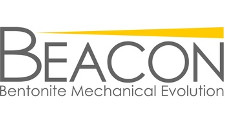
In May 2020, Quintessa staff attended a virtual meeting for all partners of the Euratom Beacon (Bentonite Mechanical Evolution) project. The meeting was originally scheduled to be held at the University of Liège in Belgium, but due to travel restrictions during the Covid-19 pandemic, the decision was made to hold the meeting by videoconference.
The Beacon project began in 2017 with the aim of investigating the mechanical evolution of inhomogeneous bentonite systems. Many radioactive waste disposal programmes plan to use bentonite in buffers, seals or backfills as part of their disposal concepts. Developing understanding and predictive capabilities of bentonite homogenisation is key to building confidence in the long-term performance of bentonite barriers.
At the Annual Meeting, partners presented modelling and experimental progress and discussed plans for the final year of the project. Quintessa staff presented modelling results including a thermo-hydro-mechanical (THM) model of the FEBEX in-situ experiment which was developed in QPAC. In the final stage of the project, Quintessa staff will be participating in a benchmarking exercise to test the predictive capabilities of their model. Partners including Quintessa will also be applying their models to actual assessment cases by developing models of three repository concepts: Andra's Cigeo seals; Nagra's disposal cells; and SKB's KBS-3 deposition tunnel backfill.
Quintessa is also responsible for producing a report which will summarise learning gained during the Beacon project. This report will build on the initial state-of-the-art report produced by Quintessa at the start of the project, which includes a database of relevant laboratory and full-scale bentonite experiments. This database will be updated to reflect the latest experimental results from the Beacon project.

This project receives funding from the Euratom research and training programme 2014-2018 under grant agreement No 745942.